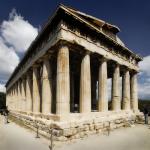|
This section contains 2,608 words (approx. 9 pages at 300 words per page) |

|
Structure of the Roman Theater.
The Romans did not construct a permanent theater until Pompey sponsored one in 55 B.C.E. Instead, as the Roman architect, engineer, and writer Vitruvius (last half of first century B.C.E.) described, the Romans built temporary wooden structures as performance spaces, and continued to do so even after the advent of permanent theaters. There may have been several political reasons for this. Conservatives argued that theater promoted immoral behavior and fought to prevent the building of permanent structures. As class divisions and personal sponsorship of occasions for performance arose, such as the annual Ludi Romani ("Roman Games"), circuses and other spectacles, and funeral celebrations for the wealthy and notable, the building of provisional theater spaces allowed for luxury seating and elaborate decorative elements. There was also a fear of seditious behavior, again due...
|
This section contains 2,608 words (approx. 9 pages at 300 words per page) |

|




